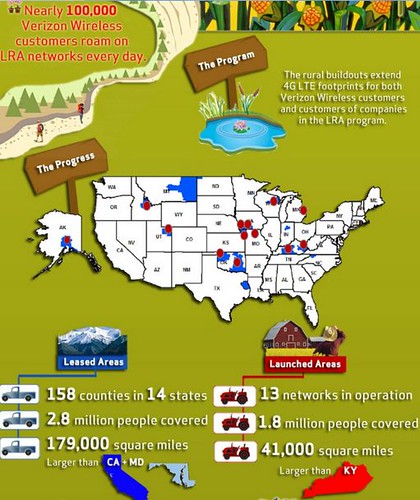Sprint is teaming up with the Competitive Carriers Association and NetAmerica Alliance to accelerate 4G LTE deployment in rural America.
 The partnership will allow CCA and NetAmerica Alliance subscribers to roam on Sprints’ LTE network and Sprint subscribers can use CCA and NetAmerica Alliance local networks.
The partnership will allow CCA and NetAmerica Alliance subscribers to roam on Sprints’ LTE network and Sprint subscribers can use CCA and NetAmerica Alliance local networks.
Sprint will provide access to 800 MHz and 1900 MHz spectrum, national reach on Sprint’s network, and access to the Sprint device ecosystem. In turn, NetAmerica Members will build local 4G LTE mobile broadband networks (Sprint Network Vision- compliant) and will share those networks with Sprint.
The collaboration is expected to enhance Sprint’s LTE coverage to 250 million people by mid-2014. Sprint’s competitior Verizon covers over 300 million customers under its LTE network.
Verizon’s rural LTE program has widened its LTE network coverage. The company leases its 700 MHz spectrum to rural mobile operators to build additional LTE networks.
Under Verizon’s Rural America program, operators must use Verizon’s spectrum, unlike Sprint’s program where operators can use their own spectrum as well. Sprint is also planning to add 700 MHz Band 12 to its devices beginning next year.
Until recently AT&T and Verizon LTE phones did not work on the 700 MHz “A block” (or each others networks). That forced most small and rural carriers into a marginal existence.
Apple’s handsets, for one example, work on AT&T and Verizon spectrum, but not A Block spectrum used by smaller companies like C Spire and U.S. Cellular. Without support by popular handsets or roaming capability, regional carriers became isolated, offering only “islands” of service in the “A” block.
 FCC Acting Chairwoman Mignon Clyburn would have none of that. She pushed for and succeeded in getting an agreement between rural carriers and the duopoly, to enable devices to interoperate in the lower 700 megahertz band.
FCC Acting Chairwoman Mignon Clyburn would have none of that. She pushed for and succeeded in getting an agreement between rural carriers and the duopoly, to enable devices to interoperate in the lower 700 megahertz band.
The FCC last year forced carriers to make their LTE phones compatible with the “A block” which adjoins the current UHF television broadcast band and the high-powered “E” block, originally conceived for regional broadcasting of mobile TV.
The Order also made changes for various E Block licensees in the Lower 700 MHz band, mostly owned by Dish. The high powered “E” Block, which could use effective radiated power of 50,000 watts, could have been problematic for “A” band users.
In announcing the ruling, Clyburn praised the collaborative efforts by AT&T, consumer advocacy groups, the Competitive Carriers Association and Dish, which helped smaller wireless carriers negotiate the interoperability deal with AT&T.
Related Dailywireless articles include; FCC Orders Lower 700 MHz Interoperability, Dish: Lower 700MHz Power Ups Speculation, AT&T and Verizon: No 700 MHz Interoperability For You!, AT&T Competitors: No 700MHz Roaming, FCC Announces H Block Auction, Dish Won’t Bid on H Block Spectrum, AT&T Buying Leap Wireless (Cricket), FCC Limits Dish on LTE Terrestrial Spectrum, Dish: On the Move, Dish and Sprint Battle over PCS band Extension, FCC Approves 2.3 GHz for AT&T, AT&T Likely to Get 2.3 GHz, Sprint’s Dish Compromise
Posted on Thu, 27 Mar 2014 17:13:21 +0000 at http://www.dailywireless.org/2014/03/27/...eployment/
Comments: http://www.dailywireless.org/2014/03/27/.../#comments

